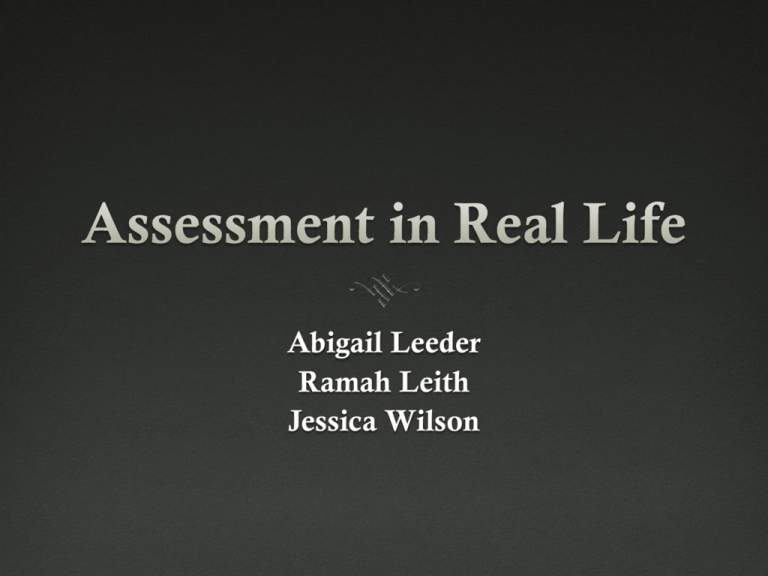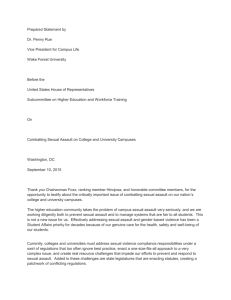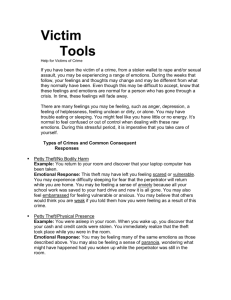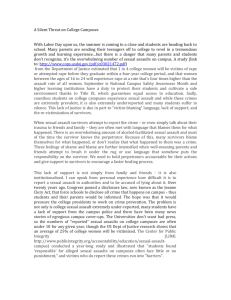Be That Guy
advertisement

Abigail Leeder Ramah Leith Jessica Wilson Program Outcomes Participants will be able to describe the steps in the assessment cycle. Participants will be able to identify strategies to use at each step of the assessment cycle. Participants will be able to write an assessment plan for a project. Cycle of Assessment Types of Assessment Tracking – monitoring who uses our programs, services and facilities (e.g. raw numbers, frequency, age, class standing, gender, race, residence, etc). Needs Assessment – identifying needs of our students and clientele (e.g. student perceived, research supported, and institutionally expected). Satisfaction Assessment – measuring the level of student and clientele satisfaction with our programs, services, and facilities. Student Cultures and Campus Environments Assessment – assessing the collective perception of campus and student experience (e.g. campus climate, academic environment, residential quality of life). Cost Effectiveness Assessment – determining whether the programs, services and facilities we offer to students are worth the cost. Assessment Types Learning Outcomes Assessment – measuring the impact our services, programs and facilities have on students’ learning, development, and student success. Comparable Institution Assessment – identifying how the quality of our programs, services and facilities compare with peer institutions’ best practices. National Standards Assessment – using nationally accepted standards to assess our programs and services (e.g. national assessment inventory– EBI, CAS standard self-assessment, departmental review by consulting group). Real Life Abigail Leeder- Student Learning, One Time Workshop Assessment Jessica Wilson- Needs Assessment Ramah Leith- Tracking Assessment Abigail Leeder- Student Learning, Student Leader Assessment Step One: Define PROGRAM/DEPARTMENT GOALS The Sexual Wellness Advocacy Team (SWAT) a group of student educators that use theatre and other interactive activities to educate their peers about sexual assault and healthy relationships. http://www.youtube.com/watch?v=BhiGiUnJXps Step One: Define PROGRAM/DEPARTMENT GOALS Train 18 students per term to serve as peer educators on issues of Sexual Assault & Dating Violence Present 90 minute educational programs to at least ten student groups per term that educate campus audience on the dynamics of sexual violence Present the original production “It Can’t Be Rape” to all incoming students at IntroDUCKtion on the Dynamics of Sexual Violence Step One: Define After attending a SWAT Educational presentation students will be able to: Understand the definition of consent (in the context of sexual activity) Recognize and name common myths around sexual violence. Identify and model appropriate bystander behaviors Be able to list existing campus and community resources available to survivors of sexual violence. Step One: Define Through SWAT presentations we wish to: Humanize the experience of being a sexual assault survivor by inviting audience members to empathize with a character in that position Place sexual assault in context of the experience of a college student Give students the ability to recognize dangerous and oppressive behaviors of perpetrators of sexual assault Encourage further discussions among peers about the impact of sexual violence on the community Encourage communication as a core component of a healthy relationship Step Two: Program DESIGN PROGRAM TO MEET OUTCOMES Through a weekly class and a two-day retreat Peer Educators develop 90 minute presentations using theatre and other interactive training methods to meet desired outcomes IMPLEMENT PROGRAM Present to residence halls, fraternities and sororities, student groups Step Three: Assessment Methods HOW DETERMINE WHAT YOU WILL MEASURE? A desire to understand the impact on student learning and the effectiveness of the presentations in reaching learning outcomes WHAT DID YOU USE TO MEASURE IMPACT OR GATHER DATA? Half-sheets of paper filled out at the end of the workshop and entered into StudentVoice HOW DID YOU ANALYZE THE DATA? Percentages Step Four: Evaluation BASED ON DATA, HOW EFFECTIVE WAS THE PROGRAM AT MEETING YOUR OUTCOMES? Spring Term Workshop Evaluations 259 Respondents Step Four: Evaluation Step Four: Evaluation WHAT DID YOU DO WITH THE DATA TO INFORM YOUR NEXT STEPS OR FUTURE PLANNING? Presenters read through after each presentation and make adjustments We evaluate results on a whole at each planning retreat WHERE DID YOU REPORT THE RESULTS? Here! Step One: Define GOALS 1. To assess how well the UHC was meeting the needs of our LGBTQ student population 2. To assess LGBTQ students’ perceptions of the UHC 3. To gather this information that is relevant to the clinical population Step One: Define OUTCOMES 1. The UHC will identify areas of growth 2. The UHC will dedicate time to make changes in order to serve the LGBTQ student population well Step Two: Program Campus colleague assistance LGBTESSP for students comments and good use of language UCTC for facilitation of focus groups Step Three: Assessment Methods What will speak loudest to the clinical staff; Qualitative data Quantitative data Assessment; Gathering Data Student in-service Focus groups Colleague experience Student Voice Data Analysis Focus Groups Confidential, taped conversations. Noted trends, and outliers Student Voice Numbers and trends provided Step Four: Evaluation Did we need to do all four types of assessment?!?! No…and yes All information was consistent, but knowing the audience was much more important Evaluation: Next steps Presentations at various UHC committees UHC commissioned a task force to report on data and make recommendations Final report was given to UHC’s Executive members for endorsement Diversity Action Committee charged with making sure changes are implemented Step One: Define PROGRAM/DEPARTMENT MISSION Health Promotion’s Department Mission: We work to develop healthy campus communities that support students in reaching their full potential by providing health promotion, education and prevention information and services. In addition we are committed to providing student leadership opportunities under the guidance of social justice within a public health framework. Step One: Define PROGRAM GOALS Mission: Be That Guy is a campaign meant to advocate, highlight and support all the great men we have on this campus by empowering them to be active and engaged around sexual assault prevention issues. Goal: To educate and empower UO men about sexual assault prevention and how to not be a silent bystander when witnessing possible sexual assault situations. Step Three: Assessment Methods WHAT DID YOU USE TO MEASURE IMPACT OR GATHER DATA? Online Survey HOW DID YOU ANALYZE THE DATA? what marketing practices were most useful events most attended BTG products received campus and community affiliation Take Back the Night Tabling and/or Event Wellness Wednesday 6% Article in the Emerald Tabling in 2% EMU the EMU Concourse 9% Display 4% Counseling Center Gallery Wall 2% Health Center Lobby Board 3% Fraternity 10% Packets Handed out by Peer Health UO Men's Center 4% 4% Daily Emerald Ad Marketing Facebook 26% Peer Health Educator 19% Housing Flyer 3% Presentation Given to your Organization/Gr oup 3% Respondents Affiliation UO athlete UO Fraternity member Past or Current Peer Health Educator UO Faculty/Staff Community Member UO Alumni UO student 3% 22% 53% 7% 6% 1% 8% Events Monday Picture Taking Bystander Day Intervention 12% Presentation 23% Monday Thursday EMU tabling Tuesday - 5K 20% Run 12% Thursday Take Back the Wednesday Night Event MOTIVATE 26% Walk 7% Step Four: Evaluation Advertise earlier. Provide more of an incentive to get participation. Offer several nights for the Bystander Intervention Training so more men can attend. Get more campus groups involved. Have a better location for the Bystander Intervention Training. Step Four: Evaluation WHERE DID YOU REPORT THE RESULTS? Director of Health Promotion Director of the Health Center Program and campus partners Possible publications in College Health Journals. Possible presentations at the Oregon College Health Association Conference and the American College Health Association Conference. Step One: Define PROGRAM/DEPARTMENT MISSION Same as previous slides on SWAT. Step Two: Program DESIGN PROGRAM TO MEET OUTCOMES Curriculum development Guest Speakers, Reading Materials, Campus Initiatives Incorporation of Best Practices in teaching and peereducation IMPLEMENT PROGRAM Weekly classes, workshops, retreats Step Three: Assessment Methods HOW DETERMINE WHAT YOU WILL MEASURE? Desire to assess student learning WHAT DID YOU USE TO MEASURE IMPACT OR GATHER DATA? End of term surveys, anonymously filled out that assess fulfillment of learning outcomes HOW DID YOU ANALYZE THE DATA? Studentvoice.com, data entered by student worker Step Four: Evaluation BASED ON DATA, HOW EFFECTIVE WAS THE PROGRAM AT MEETING YOUR OUTCOMES? Spring 2011 14 Respondents Step Four: Evaluation Step Four: Evaluation Q27. Do you have any other comments or suggestions about the SWAT experience? Although greek life does need our help, we should try to outreach to more identity based unions, so our resources are more fairly allocated to broader spectrum of the community. More youth education! Lets get swat into high schools and junior high populations. Best club, activist organization, student leadership experience on campus. life-changing. swat enriched my college experience by providing a safe community of UO students committed to a common cause of ending sexual violence and learn together. I love swat and Abigail! I LOVE SWAT. One of the best parts of college. I wouldn't have been able to cope with my own victimhood of sexual assault without it. I will miss SWAT more that I can ever explain. SWAT is my family. I will always love it and feel blessed to have been a part of it. Thank You. We should get more funding because we rock! Step Four: Evaluation WHAT DID YOU DO WITH THE DATA TO INFORM YOUR NEXT STEPS OR FUTURE PLANNING? Read, envision, incorporate WHERE DID YOU REPORT THE RESULTS? Here!





